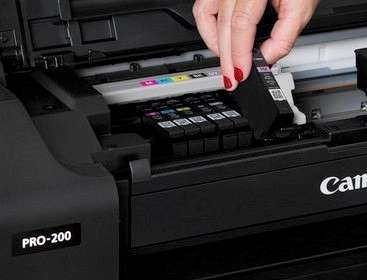CANON PIXMA PRO-200: A dye-based A3+ inkjet printer with a small footprint that is currently the most economical to run in its class. It’s a significant improvement on the PRO-100 model it replaces; more compact, better designed and easier to operate. It also appears to deliver richer, more accurate colours.
RRP: $899

Canon’s PIXMA PRO-200 replaces the PIXMA PRO-100S, which was a minor update to the 2012 model. Providing an alternative to the pigment-based imagePROGRAF PRO-300, it’s designed for photographers who prefer printing on glossy or lustre papers. Physically similar to the PRO-300, it uses the ChromaLife100+ dye inkset with updated magenta and black inks that encompass a wider gamut range for reds and blues plus higher black density.
Like the PRO-300, the PRO-200’s inks ride on the print head, which means smaller and lighter cartridges are required, and far less ink is wasted in set-up, etc. Cartridge capacities are relatively modest at 12.6 ml per colour. Interestingly, the US-based Red River Paper company recently measured ink consumption across a range of popular A2 and A3 printers and found the PRO-200 to be one of the most economical printers to run. Their findings are backed by our tests.
Small cartridges have enabled Canon to make both the PRO-200 and its sibling remarkably small for an A3 printer. Like the PRO-300, it features a built-in colour LCD control panel that makes it easy to set up and operate. Only two paper feeds are provided, a main top feed for papers up to 300 gsm and a manual feed that flips out from the back of the printer for heavier papers. Paper is fed in centrally, as in the PRO-300 and the printer includes a skew correction function to prevent misalignment. The control panel can also be set to detect paper mismatches and display an error message. Like the PRO-300, the PRO-200 can’t use roll paper but, unlike the PRO-300 it should not be used for printing on canvas.
Three connectivity methods – Wi-Fi, Ethernet and USB – allow it to be used in different environments including the office or studio, shared work spaces and at home. Note that when connecting to a wireless network you’ll need passwords and permissions and you may need to reset security clearances. The small footprint of just 639 x 379 x 200mm and relatively light weight of 14.1 kg make the PRO-200 easy to set up and move between work spaces. We encountered no issues when setting up and operating the review printer. We also found it produces excellent output quality with both the Standard and High quality settings.
Purchasing points:

1. The PIXMA PRO-200 represents a significant improvement on the PRO-100 model it replaces; it’s more compact, better designed and easier to operate, thanks to the LCD control panel and improved software. The ink set also appears to deliver richer, more accurate colours.
2. Improved media compatibility enables users to print on a wide variety of photo paper surfaces and finishes with thicknesses up to 0.6mm. Canvas printing is not supported.
3. Borderless printing is available across a wide range of popular output sizes. Images will be cropped, if required, to fit paper sizes with different aspect ratios from the camera. The printer’s control panel will alert users if borderless printing is selected for a size that is not supported, such as Plain Paper.
4. Either slot can be used for printing on custom-sized media, which is available in a range of widths from 89 to 330.2mm and lengths from 127 to 990.6mm. This enables users to print on non-standard paper sizes, including panoramas. It’s not available when the Borderless box is checked.
5. The PRO-200 uses Canon’s standard driver software, which can be downloaded from the company’s website. Users can also access Canon’s Professional Print & Layout and Media Configuration Tool, which can be used to print directly from Canon’s Digital Photo Professional or can operate as standalone software or as a plug-in with Adobe’s editing software. PosterArtist Lite design software is available for Windows users.
6. The ‘canned’ profiles cover all the current Canon media, excluding canvas. ICC profile support is available for third-party media, although some manufacturers have yet to provide profiles for this printer. (We found the dye inks to be quite forgiving and obtained good results by using the nearest ‘canned’ profile to the third-party paper.)
7. Canon’s Media Configuration Tool is a customisable software utility that registers new media types selected by the user to the printer and related software. When new paper supported by the printer is added, the media information file can be downloaded and added to the printer.
8. In our tests, we found the printer used 37.8ml of ink to cover just under 4.6 square metres of paper. Prices for the PRO-200’s ink cartridges vary widely, ranging from just under $30 to just under $21 per cartridge. At these prices, an A4 print will cost between $1.03 and 71 cents in ink, with an A3+ print costing between $3.40 and $2.35.
9. We encountered no issues when setting up and operating the review printer. We also found it produces excellent output quality with both the Standard and High quality settings, with the main differences showing as slightly better detail resolution in medium-density areas with the High quality setting.
10. The PIXMA PRO-200 is supported by a two-year warranty.
Distributor: Canon Australia; 1800 021 167; www.canon.com.au
Click here for a more extensive review
for a more extensive review





If Canvas is not supported, then why have they got a canvas facility on my Pro-200?